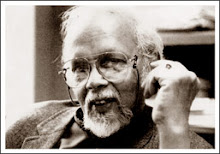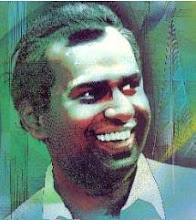Author: Indeewara Thilakarathne
Source: Sunday Observer
Date: 18/09/2005
 "Sinhabahu" and "Maname" are the best-known theatrical magnum opus' of the late Professor Ediriweera Sarachchandra who dominated the cultural scene for decades as a playwright, academic and novelist. He was the chief priest and proponent of what we know as the "Peradeniya School".
"Sinhabahu" and "Maname" are the best-known theatrical magnum opus' of the late Professor Ediriweera Sarachchandra who dominated the cultural scene for decades as a playwright, academic and novelist. He was the chief priest and proponent of what we know as the "Peradeniya School".
"Sinhabahu" is now being staged islandwide.
The play is based on a legend associated with the origin of the Sinhala race. According to the legend, the race Sinhalese was born from a lion. Suppadevi, the main female character in the play is the eldest daughter of the king of Vanga Desa (modern Bengal). On her birth, soothsayers predict that she will cohabit with a king of beasts, the Lion. The father, the king, takes precautions to protect her.
She is kept in the palace under heavy guard. However she is adventurous and dupes her guards and escape from their protection. Her adventurous nature lured her to wander from village to village and finally she reaches the boundaries of a forest.
There she encounters a caravan of merchants and the riders offer to take her back to the palace. In the forest the Lion attacks the caravan and abducts her to his den where they live as husband and wife.
 She bears him a son, named Sinhabahu (denotes prowess and attracts respect) who has a strength of a lion and a daughter, Sinhasivali.
She bears him a son, named Sinhabahu (denotes prowess and attracts respect) who has a strength of a lion and a daughter, Sinhasivali.
In his youth, Sinhabahu recognises the physical difference between his mother and father and questions his mother. When he learns the story he tries to leave the den. The mother tells him that the cave is covered by a huge rock and their escape was impossible. One day, Sinhabahu breaks open the door and flees leaving the lion.
They reach the kingdom of Vanga. In the main historical chronicle the Mahawamsa "when the lion returns and learns of the departure of the three (persons), the grief-stricken lion roams the villages and townships in search of them.
Every village he went was deserted by dwellers "Though the king offered a reward of thousand then two and three thousand gold pieces, no one came to face the lion. The chronicle says that twice the mother restrained Sinhabahu. However on the third occasion, Sinhabahu took the three thousand gold pieces for the slaying of his own father.
The encounter between the father and son is described thus: "And he went forth to the opening of the cave, and as soon as he saw, from afar the lion, who came forward feeling love towards his son, he shot an arrow to slay him. The arrow struck the lion's head but because of his tenderness (towards his son) it rebounded and fell on the earth at the youth's feet. So it fell out three times. Then did the king of beast grow wrathful, and the arrow sent at him struck him and pierced his body. Sinhabahu gains victory and established a city named Sinhapura and crowns himself as ruler.
In the myth, Sinhabahu marries his sister and produces a rebellious son, Prince Vijaya. He is banished with a boatload of seven hundred followers. They are caught in a storm and washed ashore on the land of Lanka and Prince Vijaya marries its ruling queen, Kuveni. Since he is a grand son of a lion his decedents totemise a lion race known as Sinhala.
It is arguable that the reference to a lion with whom the main female character of the play Suppadevi cohabits was idiomatic and it probably was a king, brave and strong and wears a lion's headdress and skin as insignia to identify his tribe or clan. It is therefore possible that the convoy of caravans that accompanied Princes Suppadevi would have mistaken the king as literary lion.
Princes Suppadevi who was endowed with "womanly qualities" would have fallen in love and eloped with him.
However, based on the story of the chronicle, many versions of narratives have evolved over the years, regarding Suppadevi and her cohabitation with the lion. This can be traced back to the Siyabas Maldama (Garland of Flowers of Cernacular Languages), a long narrative poem composed around 1920 by Ven. Kiraba Dhammananda.
Later, the story of the poem was adopted for a play called Sinhavalli Nadagama by Philippu Singho, a reputed playwright of the time. Nadagama is the Sinhala derivative of the Tamil word Natakam, a concept and a word based on a Sanskrit dramatic tradition.
"It is a kind of theatre comprising music, gesture embellishment or alamkaram rhythm and the nine relishes or nava rasa". Towards the end of the last century another playwright C. Don Bastian Jayaweera Bandara adopted the play and used the nurthi style influenced by the North Indian dramatic tradition.
The main feature of the nurthi is that it is divided into scenes and acts like in European drama. And in nurthi the Pote Guru, the narrator or the presenter of the old Nadagama vanishes from the stage.
Jayaweera Bandara's play was also Sinhabahu and in the 1940s another playwright Ampe. Charles Gunasinghe adopted the same story but with the name Sinhavalli. A novel titled "The Fountains of Sinhala" by Collin de Silva also bears the same theme. Almost all the authors have treated the story as a historical legend except Collin de Silva who projects the story in a different perspective and dimensions.
In the previous productions the character of Princess Suppadevi was portrayed as a sex symbols, passionate, weak and lustful but in Professor Sarachchandra's work, he looks" womanly as an individual with human tenderness and love.
In Maname she is indecisive, judicious helpless and foolish and in Rattaran (Gold) she is crafty and clever, in Kadawalalu (Glass Bangles) she is kind loving and innocent, in Prematho Jayathi Soko (Love Begets Sorrow) she is innocent, loving and romantic, in Loma Hansa (Golden feathers) she is anxious and craving, in Mahasara she is illogical, hasty, arrogant and vain, In Sinhabahu she is helpless and indecisive yet determined and brave.
Sinhabahu is a tragedy based on a legend. It has the rudiments of a tragedy "unshackled destroying force" in Sinhabahu, the son, "the one who is destroyed" in Lion and the will or desire of the victim to fight against forces and not be destroyed." Sinhabahu is a tragedy like Oedipus Rex or Hamlet and is based on primordial human situations and certain universal characteristics and feelings.
It is essentially a dilemma of a passionate woman who is caught between the loyalty to her husband and love towards her only begotten son, Sinhabahu.
It is not only the loyalty to her husband, the lion but the old life she has shared and the new life she has brought forth, that is amply demonstrated in her quest for her husband.
About the Playwright
Ediriweera Sarachchandra, who died in 1996 at the age of 83, is considered a great playwright. He was an equally eminent novelist, critic, philosopher musicologist and educationist.
In 1983 he was awarded the Kumaran Asan World Prize by the Kerala State of South India, and won the Ramon Magsaysay Award for Literature in 1988.
In 1994 Kochin State of India honoured him with the Surabi award for Arts and Literature, and in 1995 Japan awarded him with the Silver and Gold Star Treasure Award for Literature. Until his death he was the Chancellor of the University of Peradeniya.



































No comments:
Post a Comment